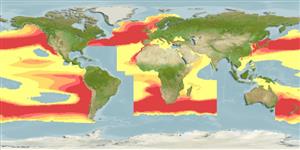Preferred temperature (Ref.
123201): 5.6 - 17.9, mean 10.1 °C (based on 809 cells).
Phylogenetic diversity index (Ref.
82804): PD
50 = 0.7500 [Uniqueness, from 0.5 = low to 2.0 = high].
Bayesian length-weight: a=0.00389 (0.00180 - 0.00842), b=3.12 (2.94 - 3.30), in cm total length, based on all LWR estimates for this body shape (Ref.
93245).
Nível Trófico (Ref.
69278): 3.8 ±0.35 se; based on food items.
Generation time: 11.0 ( na - na) years. Estimated as median ln(3)/K based on 1
growth studies.
Resiliência (Ref.
120179): Baixo, tempo mínimo de duplicação da população 4,5 - 14 anos (K=0.10).
Fishing Vulnerability (Ref.
59153): High to very high vulnerability (66 of 100).
Nutrients (Ref.
124155): Calcium = 22.1 [8.1, 49.5] mg/100g; Iron = 0.298 [0.130, 0.826] mg/100g; Protein = 18 [17, 19] %; Omega3 = 0.113 [0.044, 0.280] g/100g; Selenium = 17.9 [6.2, 47.0] μg/100g; VitaminA = 33 [4, 264] μg/100g; Zinc = 0.487 [0.266, 0.950] mg/100g (wet weight);
